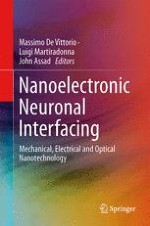
2014 | OriginalPaper | Buchkapitel
1. Carbon Nanotubes for Neuron–Electrode Interface with Improved Mechanical Performance
verfasst von : David Rand, Yael Hanein
Erschienen in: Nanotechnology and Neuroscience: Nano-electronic, Photonic and Mechanical Neuronal Interfacing
Verlag: Springer New York
Aktivieren Sie unsere intelligente Suche, um passende Fachinhalte oder Patente zu finden.
Wählen Sie Textabschnitte aus um mit Künstlicher Intelligenz passenden Patente zu finden. powered by
Markieren Sie Textabschnitte, um KI-gestützt weitere passende Inhalte zu finden. powered by